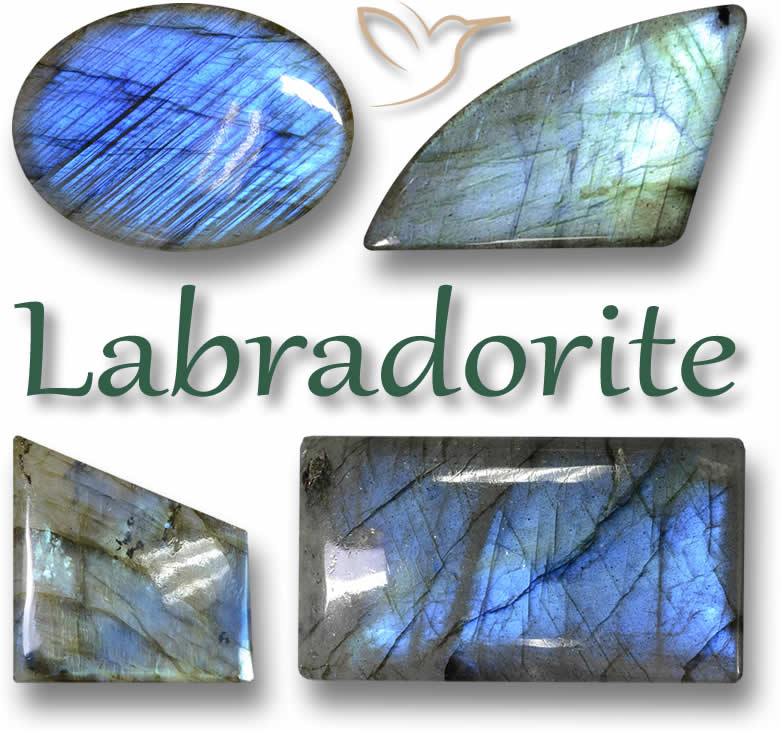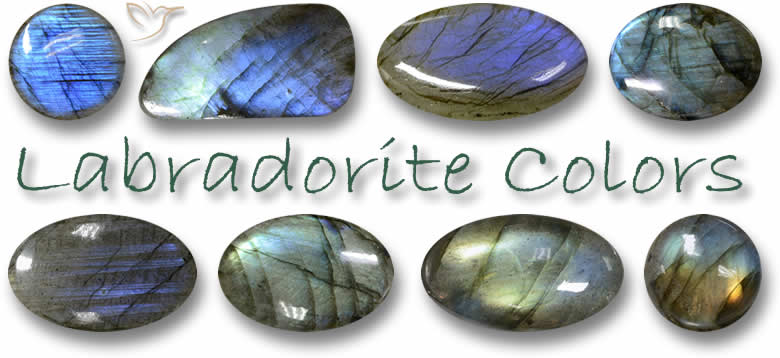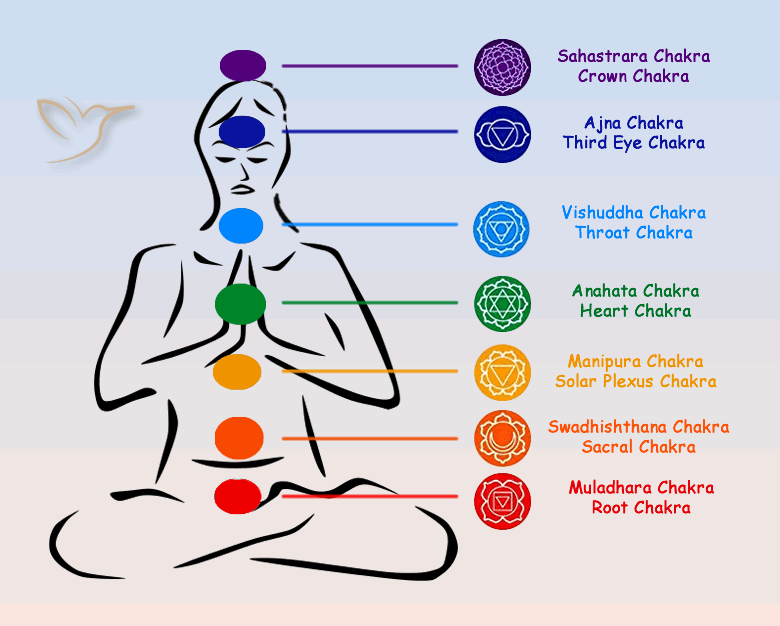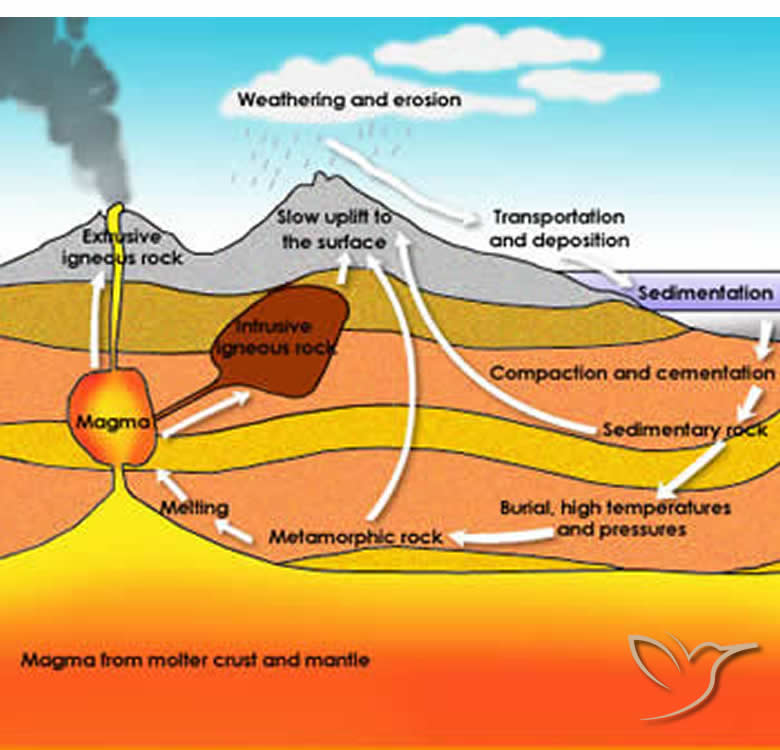Labradorite Gemstone Information

Introduction
There are few gemstones that display the 'play-of-color' phenomenon better than Labradorite. Reds, blues, purples, yellows, and more dance before your eyes as it turns in your hand. But there's much more to learn about Labradorite's iridescence and mystic glow.
The Schiller effect, labradorescence, light interference, lattice distortions - these are some scientific explanations for the flashes of color in Labradorite gemstones. We'll dive into those later. But maybe the Inuit people of Labrador in Canada put it best: They say the Northern Lights, or Aurora Borealis, got trapped within Labradorite rocks.
Legend has it that a mighty Eskimo warrior freed those dazzling polar sky colors with strikes from his spear. He couldn't shatter all the rocks, though, leaving some Labradorite gemstones for us to gather, shape, polish, and enjoy today.
Labradorite Colors

You might be surprised, but the varied colors in a high-quality Labradorite aren't actually in the gemstone itself or from mineral impurities. Labradorite consists of thin layers of different minerals. As light passes through, it splits white light into rainbow colors that bounce back, deflect, absorb, and flash before your eyes.
This isn't a common trait, and it goes by names like adularescence, labradorescence, and aventurescence - tough to pronounce, so folks came up with 'Schiller effect,' from an old German word for sparkle or play-of-color.
Most Labradorite has a dark base with blue, green, yellow, or red flashes. Gold, purple, teal, orange can show too. Stones with strong colors or a full rainbow are most prized.
Labradorite Species
Labradorite is a feldspar, the most abundant mineral on Earth - a mix of silica and aluminum making up over half the crust.
The right blend of sodium (Albite) and calcium (Anorthite) with silicon and aluminum creates Labradorite. Moonstone, Sunstone, and Amazonite share similar compositions and are feldspars too.
- Spectrolite
- A trade name for high-quality colorful Labradorite from Finland only. (Sometimes misspelled Spectralite)
-

Natural Spectrolite Gemstones - Andesine
- A Labradorite type with similar makeup but different looks. Andesine (sometimes called Red Labradorite) is orange to red, usually faceted and transparent.
-

Natural Andesine Labradorite Gemstones - Sunstone
- Transparent or translucent with glittery hematite inclusions in yellow, orange, red. Chemically like Labradorite. There's Star Sunstone too.
-

Natural Sunstone Gemstones - Rainbow Moonstone
- A Labradorite variety with shimmering iridescence and blue glow.
-

Natural Rainbow Moonstone Gemstones
Labradorite Clarity and Cut

Gemstones fall into three clarity types, with variations. Opaque ones block all light. Translucent let some through but aren't clear. Transparent allow full passage, letting you see through.
Standard Labradorite is opaque to translucent, but practically opaque. Play-of-color shines best on dark backgrounds, yet a near-translucent surface boosts the effect.
As an opaque stone, Labradorite gets cut into cabochons - rounded domes. This gem's appeal lies in its play-of-color from light scattering off mineral layers. Cutting to maximize this is tricky.
What is the Spiritual Meaning of Labradorite?
Disclaimer: The information on spiritual meanings, chakras, and potential health benefits is for educational and entertainment purposes only. It is not a substitute for professional medical advice, diagnosis, or treatment. Always consult a qualified healthcare provider for any medical concerns.
Labradorite, known as a transformative stone, aids those facing life changes - by choice or circumstance. Switching jobs, handling loss, moving, ending relationships, or adopting healthier habits often brings stress. Labradorite can help build inner strength to push through and succeed.
It's great for workplaces, boosting communication, teamwork, and dedication. It creates enjoyable environments, welcomes customers, and lifts performance.
This stone brings emotional positivity, adding enthusiasm to daily life and joy from family, friends, and surroundings. It eases responsibility burdens, helping you value what you have.
Labradorite and the Chakras

Chakras are body energy centers, also called Qi or Prana. Seven exist, each tied to physical, emotional, or mental states and colors: Crown (purple), Third Eye (indigo), Throat (blue), Heart (green), Solar Plexus (yellow), Sacral (orange), Root (red).
Sometimes chakras unbalance or block, needing realignment. Chakra stones, colored to match, can help.
Deep blue Labradorite links to the Third Eye Chakra. If mentally lethargic, questioning life's point, indecisive, or misjudging, it might be blocked.
An overactive one shows in daydreaming, nightmares, negativity to ideas. Labradorite turns daydreams imaginative, nightmares visionary, and opens minds.
Other colors like yellow or red influence different chakras.
Health Benefits of Labradorite
We aren't experts, but we've gathered some insights on using gemstones for spiritual or health purposes. Wearing as jewelry is simplest for influence.
Carry in purse or pocket as touchstones. Hold or place on lap meditating. Or lie with stones aligned to chakras.
Stress and depression affect body too. Labradorite may address both, offering physical benefits.
It's thought to aid respiratory, metabolic, digestive systems; PMS, rheumatism, arthritis, gout symptoms; and high blood pressure regulation.
Cleanse biweekly: Run under tepid water, dry in sun an hour. Natural water best, but tap works.
For deep cleanse, bury in natural soil a day, mark spot, then rinse.
Labradorite Price

Labradorite Price List |
||
|
Color |
Weight range |
Price range / USD |
|---|---|---|
|
Multicolor |
1ct + |
$0.5 - 4/ct |
For standard dark-background Labradorite with play-of-color, color matters most: Bright, vivid like peacock feathers are top value.
More flash on rotation is better; red/orange rarer, costlier. Full-rainbow specimens are exceptional.
Cabochons in any size; large colorful ones suit unique jewelry.
Transparent yellow follows 4Cs: color, clarity, cut, carat.
For Andesine, Spectrolite, etc., check their pages.
Labradorite Discovery and History

Inuit knew it as fire stone with legends, but official identification came in 1770.
Moravian missionaries found it on Isle of Paul, Labrador, trading for supplies.
Spectrolite emerged in Finland during WWII anti-tank work.
Where is Labradorite Found?

From Labrador, Canada, also Russia, Australia, Mexico, US, Madagascar; Spectrolite in Finland.
How is Labradorite Formed?
Feldspar forms in igneous, metamorphic, sedimentary rocks via magma crystallization, heat/pressure, or sedimentation.

Heat/pressure melt/mix rocks/minerals. Slow cooling separates layers in igneous rock, creating color play.
Specific mix and slow cooling needed; else, similar rocks lack shimmer.
Can Labradorite be Treated?
Standard Labradorite isn't treated beyond cutting/polishing.
Yellow Andesine may be diffused; we disclose treatments.
What Jewelry is Labradorite Suitable For?
At 6–6.5 Mohs, fine for most jewelry, but protect rings/bracelets from knocks.
Softness allows carving or intaglios.
Large unique shapes ideal for custom or artisan pieces.
How to Care for Labradorite
Store in fabric-lined box or soft cloth. Keep from harder/softer gems.
Clean with warm soapy water, soft brush; rinse, dry. No ultrasonics/steamers. Remove for activities.
How Can You Tell a Real Labradorite?

Buy from reputable dealers, but when hunting deals, know what to expect.
Study examples online or in stores.
Unique play-of-color differs from Opal/Fire Agate.
Flash from within, changes angles. Fakes stay colorful.
Too cheap? Suspicious.
Hardness tests unhelpful.
We guarantee as described, with returns.
What is So Special About Labradorite?
Labradorite feels magical. Hold a good one, twist it - colors appear, vanish. That's the wonder.
Peacock blue flashes top, yellow-orange dances bottom. Blue returns with green. Called labradorescence, unique here.
Each turn reveals new sights, distracting from the last.
Can Labradorite Change Color?

Some gems shift color dramatically by light: Garnet red indoors, green outside.
This happens in Alexandrite, Garnet, some Sapphires. Labradorite's play-of-color isn't color-change.
Labradorite - Gemological Properties
|
Chemical Formula: |
NaAlASi3O8 to CaAl2Si2O8 Sodium calcium aluminum silicate |
|
Crystal Structure: |
Triclinic; platy, prismatic |
|
Color: |
Dark grey to grey-black, with colorful iridescence. Also colorless, orange-red and brownish |
|
Hardness: |
6 - 6.5 on the Mohs scale |
|
Refractive Index: |
1.559 - 1.570 |
|
Density: |
2.65 - 2.75 |
|
Cleavage: |
Perfect |
|
Transparency: |
Transparent to opaque |
|
Double Refraction or Birefringence: |
0.008 to 0.010 |
|
Luster: |
Vitreous |
|
Fluorescence: |
Yellow striations |
Frequently Asked Questions
What is Labradorite?
Labradorite is a feldspar mineral known for its iridescent play-of-color, often displaying flashes of blue, green, yellow, and other hues.
What causes the colors in Labradorite?
The colors result from light interfering with thin layers of minerals within the stone, splitting white light into a spectrum that reflects back.
Is Labradorite expensive?
Prices range from $0.5 to $4 per carat for multicolor varieties, depending on color intensity, play-of-color, and size.
Where does Labradorite come from?
It's found in Canada (Labrador), Finland (Spectrolite), Russia, Australia, Mexico, the US, and Madagascar.
How do I clean Labradorite?
Use warm soapy water and a soft brush, rinse well, and dry with a soft cloth. Avoid ultrasonic cleaners or steam.
Can Labradorite be used in rings?
Yes, but due to its hardness of 6-6.5, it's better for less exposed items like pendants or earrings to avoid scratches.
What is labradorescence?
It's the unique iridescent effect in Labradorite where colors appear to shimmer from within as the stone moves.
Is Labradorite the same as Moonstone?
No, but they're related feldspars. Rainbow Moonstone is a variety of Labradorite with a blue glow.

